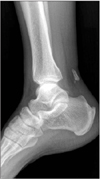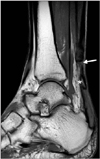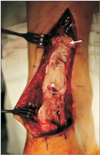Abstract
Tendoachilles rupture has recently seen an increase in frequency, accounting for up to 40% of all tendon ruptures. However, an acute segmental rupture of the Achilles tendon is very rare with only one case caused by predisposing factors, such as steroid injection. In this report, we highlight an unusual clinical presentation of a segmental rupture of the Achilles tendon without any underling predisposing factor and without direct trauma. Herein, we discuss its mechanism. Twelve months after surgical repair with open technique, this patient became fully functional again in daily activity.
Figures and Tables
 | Figure 1The preoperative radiograph shows 2 cm sized avulsion fragment located 3 cm above the upper margin of calcaneal tuberosity and loss of Kager's triangle. |
 | Figure 2The preoperative sagittal magnetic resonance imaging shows tear of the Achilles tendon at 6 cm proximally from calcaneal insertion site (arrow) and the superficial fiber rupture of Achilles tendon combined with avulsed fracture fragment (asterisk). |
 | Figure 3Intraoperative photographs of the Achilles tendon shows about 80% partial tear of the Achilles tendon at 6 cm proximally from calcaneal insertion site (arrow) and the superficial fiber rupture of Achilles tendon combined with avulsed fracture fragment (asterisk). |
 | Figure 4(A) Achilles segmental rupture was respectively repaired by Krackow method and suture bridge technique. (B) Paratenon was completely repaired. (C) Postoperative radiograph. |
References
1. Nistor L. Surgical and non-surgical treatment of Achilles tendon rupture. A prospective randomized study. J Bone Joint Surg Am. 1981; 63:394–399.

2. Arner O, Lindholm A. Subcutaneous rupture of the Achilles tendon; a study of 92 cases. Acta Chir Scand Suppl. 1959; 116:Suppl 239. 1–51.
3. Sharma V, Virmani A, Awasthi B, Singh S, Gupta M, Katoch P. Segmental rupture bilateral tendoachilles. J Case Rep. 2016; 6:531–533.
5. van der Linden PD, Sturkenboom MC, Herings RM, Leufkens HM, Rowlands S, Stricker BH. Increased risk of achilles tendon rupture with quinolone antibacterial use, especially in elderly patients taking oral corticosteroids. Arch Intern Med. 2003; 163:1801–1807.

6. Squires B, Allen PE, Livingstone J, Atkins RM. Fractures of the tuberosity of the calcaneus. J Bone Joint Surg Br. 2001; 83:55–61.

7. Wren TA, Yerby SA, Beaupré GS, Carter DR. Influence of bone mineral density, age, and strain rate on the failure mode of human Achilles tendons. Clin Biomech (Bristol, Avon). 2001; 16:529–534.

8. Lee SM, Huh SW, Chung JW, Kim DW, Kim YJ, Rhee SK. Avulsion fracture of the calcaneal tuberosity: classification and its characteristics. Clin Orthop Surg. 2012; 4:134–138.

9. Erickson BJ, Mascarenhas R, Saltzman BM, Walton D, Lee S, Cole BJ, et al. Is operative treatment of achilles tendon ruptures superior to nonoperative treatment?: a systematic review of overlapping meta-analyses. Orthop J Sports Med. 2015; 3:2325967115579188.




 PDF
PDF ePub
ePub Citation
Citation Print
Print




 XML Download
XML Download